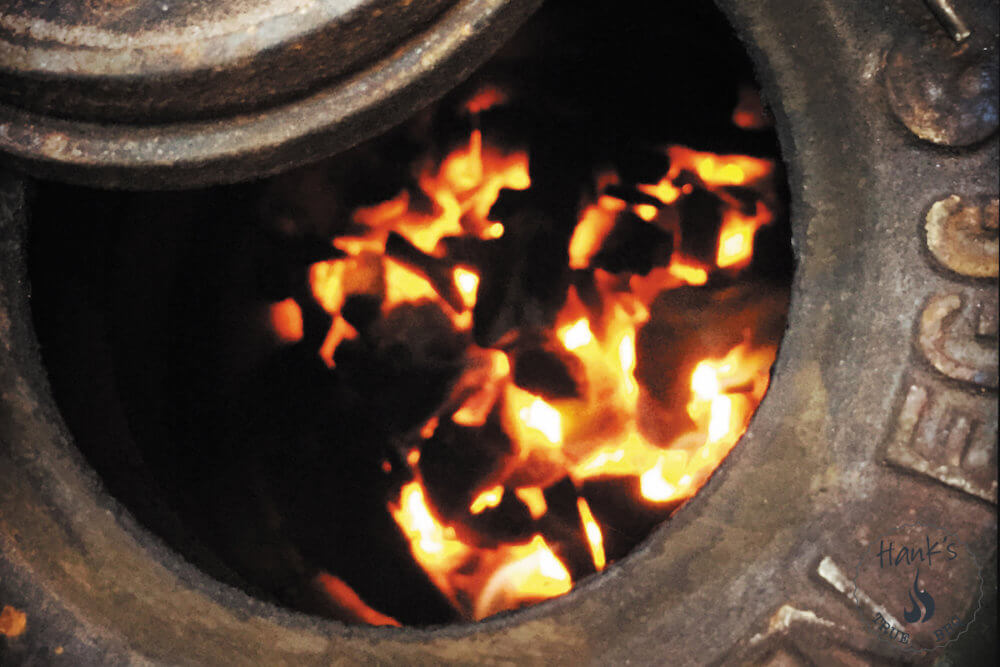If you don’t already own a Big Green Egg you can buy it at Humlebo inredning. Its a great interior decoration store run by Anders and Marie. They are passionate about both interior design and outdoor kitchens. They have good experience and knowledge about everything concerning Big Green Egg. Their store is in Almunge, a little bit east of Uppsala.
So, you have gotten yourself a Big Green Egg? Congratulations! It is an amazing grill with lots of possibilities. It is easy to use, but some tips and techniques may be helpful to for the first time user. Here are some quick links:
- How does the Big Green Egg differ from a reqular kettle grill?
- What’s the quickest way to learn?
- What type of coal should I use?
- How much coal is needed?
- What is the easiest way to light a fire?
- How do I adjust temperature?
- How do I place thermometers to measure temperature?
- Does the start procedure differ when baking pizza?
- How do I smoke in my Big Green Egg?
- Practical pointers and suggestions
How does the Big Green Egg differ from a reqular kettle grill?
Kamado
The Big Green Egg is a kamado-grill. That means it is a ceramic grill fueled with charcoal. Both the material (clay) and the shape (the egg) plays a big role when cooking. The fact that its walls are so much thicker means it holds heat better and longer, just like an old stove used in houses and apartments. The shape also allows for high humidity which gives you a better end result.
High heat mass
Since it retains heat you have to be careful when starting it up so you don’t overshoot the temp. Once you get it running it is very hard to lower the temp. Pay careful attention to the startup procedure.
Energy efficient
A kamado grill is very energy efficiet, meaning you can grill for a very long time with a small amount of charcoal. Especially when cooking “low ‘n slow”, you’ll have it running 8-10 hours easily without adding extra charcoal mid-cook.
Adjustable temperature
Another thing you’ll learn when cooking on a kamado grill is cooking at different temperatures, as well as being able to hold the same low temperature for a long time. This is something taken for granted in an indoor kitchen, but it can be replicated on a Big Greeen Egg also.
What’s the quickest way to learn?
The quickest way to learn is to simply fire it up without food. Yep, add charcoal, fire it up and let it run for an hour or two. It is a great way to learn how it behaves and how to adjust it without the added stress of actually delivering cooked food. Charcoal is cheap, and it really helps to do these dry runs.
What type of coal should I use?
There are basically four options available:
- Big Green Egg or other quality hardwood charcoal
- Lump charcoal
- Greek restaurant charcoal (Josper)
- Briquettes (never used in a BGE)
The difference between the first three is that the BGE or hardwood charcoal is made from just that, hardwood (oak and hickory), the second one is typically made from other woods that burn quicker and at a higher temp. The last one can be made from different woods. The difference is that hardwood charcoal has higher density and burns longer at a lower temp. The charcoal sold to Greek restaurants are burning too hot. The only recommended charcoal is hardwood charcoal. Briquettes are never used. Partly because they contain chemicals, partly due to them producing a lot more ash which will clog up the air holes.
How much coal is needed?
That depends entirely on how long you want to cook, how much, and at what temperature. You should always add enough charcoal to cover the round ventilation (finger sized) holes in the lower part of the grill. Never use the charcoal in the bottom of the bag, they are too small, pack too hard and prevent proper airflow.
What is the easiest way to light a fire?
Note: these instructions are based on grilling using indirect (low) heat. That means a target temp of 225° – 250° F, not higher. On my Big Green Egg (medium), I usually have the bottom and top vent set like this for low ‘n slow:
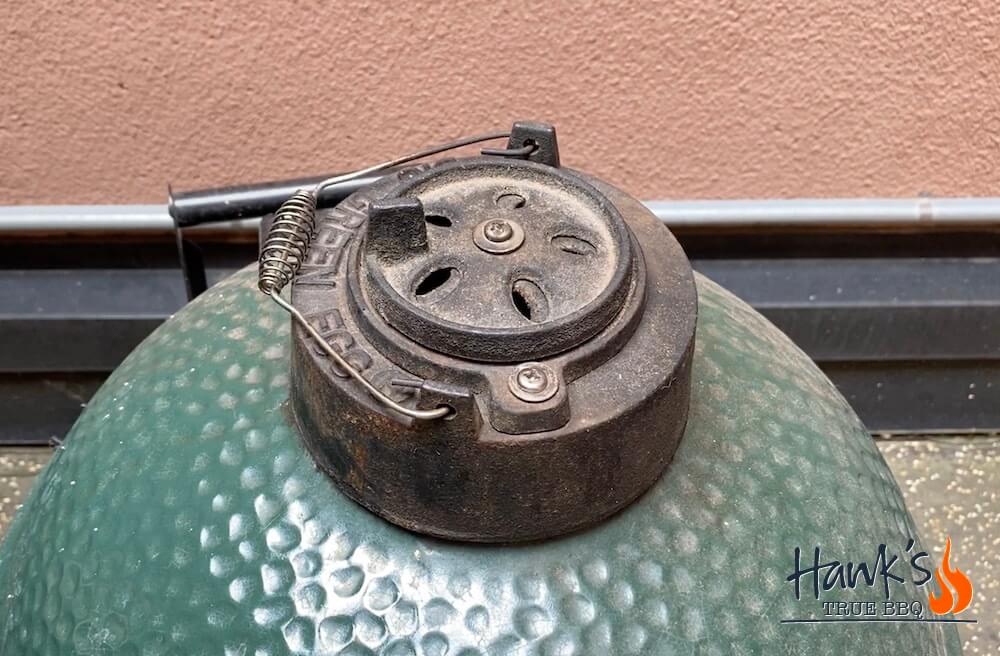
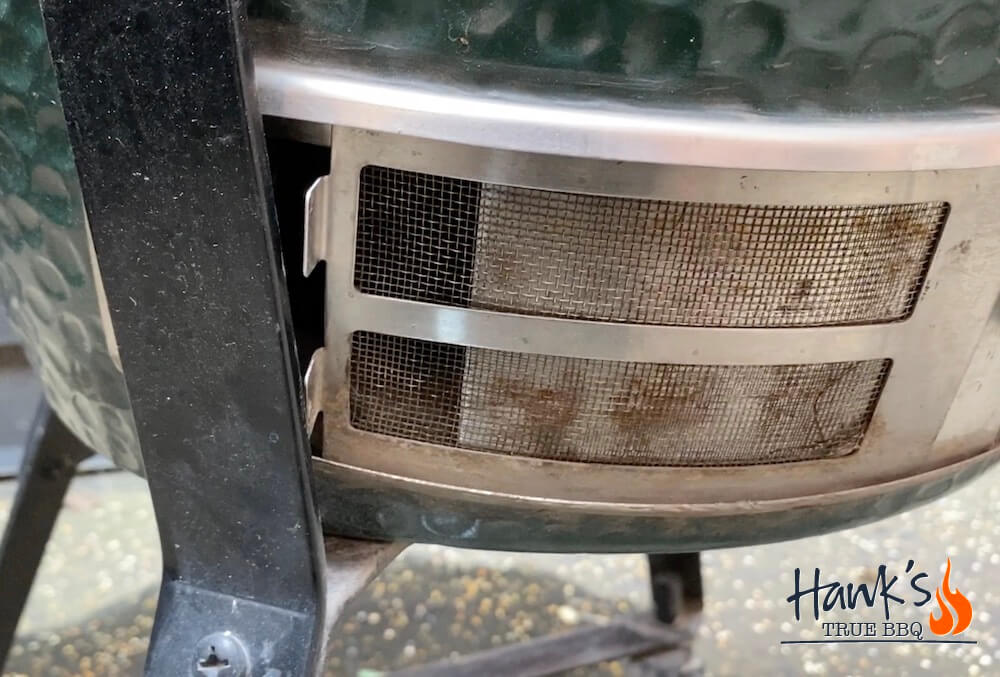
Read more on direct vs indirect heat here. A common misconception (from regular grills) is that you should have a good fire burning with all coals fully lit. On a kamado grill you want it running at “average speed”, so it lasts long. In a normal kettle grill you accomplish this using the Snake method. In a Big Green Egg you do it by setting fire to only some of the coals. The fire will spread to neighboring coals as time passes. Again, this is to keep the temperature down.
Make sure the bottom and top vents are fully open. See picture below for the top vent.

The easiest way to start a fire is to use lighter cubes. Never use lighter fluid. I use one, and I place it by the edge. It takes around 30 minutes to get the grill started. The first half hour is crucial to get it tuned to the proper target temperature. As mentioned before, it is important not to get it running too hot, as it is hard to bring down in temperature once it is running. You accomplish this by only setting fire to part of the charcoal bed. A kamado grill is often just “humming along” at low temperatures. When individual charcoal pieces burn they will ignite neighboring pieces, leading to a long lasting fire.
I consider the start procedure as somewhat of a three stage rocket. You want a clean burning fire, and all parts of the grill need to be warmed up before placing food on the grate. Compared to a sheet metal grill the walls are a lot thicker, so it takes some time to heat it all up. You need to wait for that to happen. The different parts that you want warmed up are:
- The bottom half
- The lid (with the cast iron valve)
- The heat deflector
So: don’t add the plate setter until both the lid and the bottom half have been properly wamed up. Otherwise you will risk choking the fire.
Wait 10 minutes after lighting the charcoal. Leave the lid open so the fire gets as much oxygen it needs. After the 10 minutes have passed you close the lid, but leave the top vent fully open. Let the grill get warmed up. Look closely at the color of the smoke, it will indicate whether you have a clean burning fire or not. In the beginning the fire will be white, as the charcoal starts to burn. The smoke should be almost fully transparent, that tells you it is burning cleanly. If the smoke is white is is not burning cleanly, leaving a bitter creosote flavor in your food.
Put the plate setter in place after another 5 minutes have passed, and close the lid again. Let the plate setter become warm and monitor the smoke closely, to ensure the fire doesn’t choke. If the smoke begins to thicken or billow, open the lid immediately and blow a little air so the fire starts back up. Wait a few minutes until it is burning properly again before closing the lid. Remember: as soon as you open the lid you radically change (increase) the supply of oxygen, which is great to use when starting the grill. However, it can affect the grill’s running temperature in a negative way if you’ve run it for an hour or two.
When the temperature is greater than 210° F, you close the top vent so only the small “eyes” are open. This should result in a temperature drop. Keep monitoring the fire and smoke, so it is running properly, but never chokes or become too intense. Now you can close the bottom vent halfways. This is the time where you start “tweaking” the vent settings to hit your target temperature, typically 225° – 250° F for indirect heat.

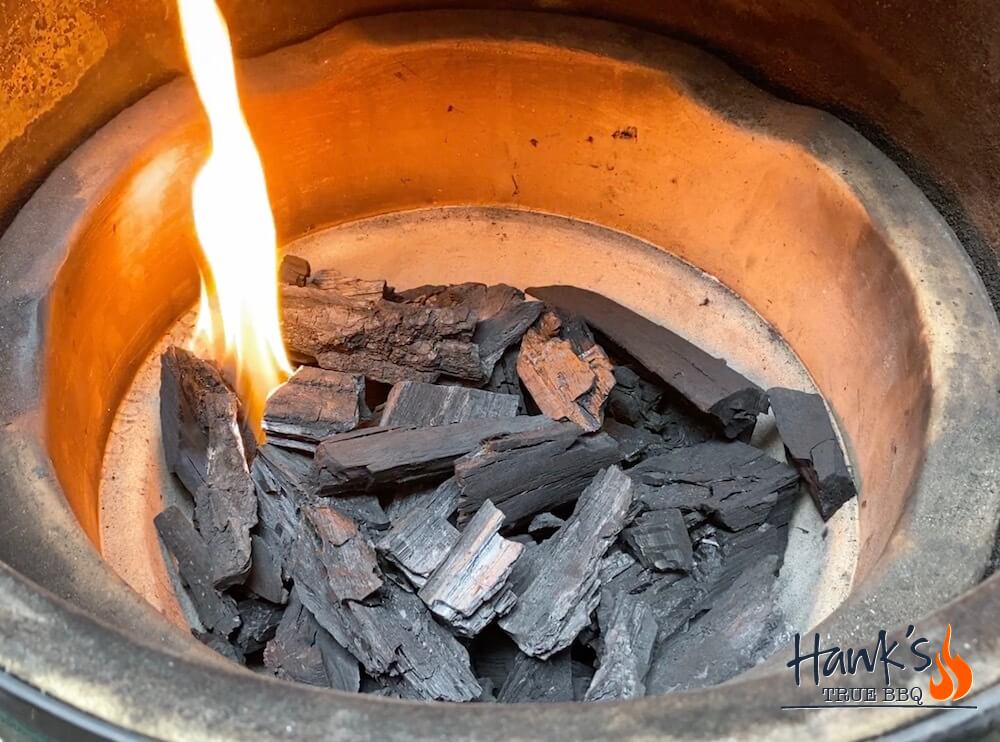
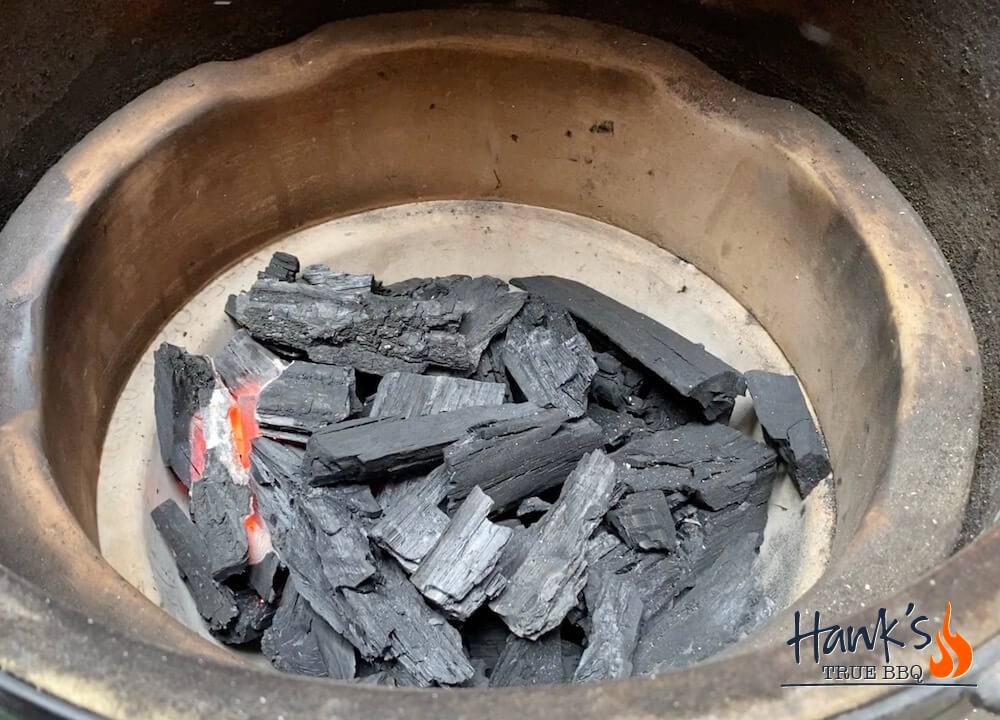
How do I adjust temperature?
Read more about temperature control here. You adjust temperature using the bottom and top vents. The lower temps adjust oxygen, and the bottom vent regulates the smoke exhaust. You may think the grill is most easily adjusted using the bottom vent, as you control oxygen, but it is actually the other way around. The top vent is used for large or coarse adjustements, and the bottom vent for tweaking. When the top vent is fully open you increase the draft, just like an indoor stove works.
How do I place thermometers to measure temperature?
Using an extra thermometer (except for the one in the lid) is an absolute must. The thermometer probe should be attached to the grate, 1-2 inches from the food. It must not be closer, as a large hunk of meat will negatively affect a correct thermometer reading (due to its mass and lower temp). You also don’t want it too far away. 1-2 inches is a good rule of thumb.
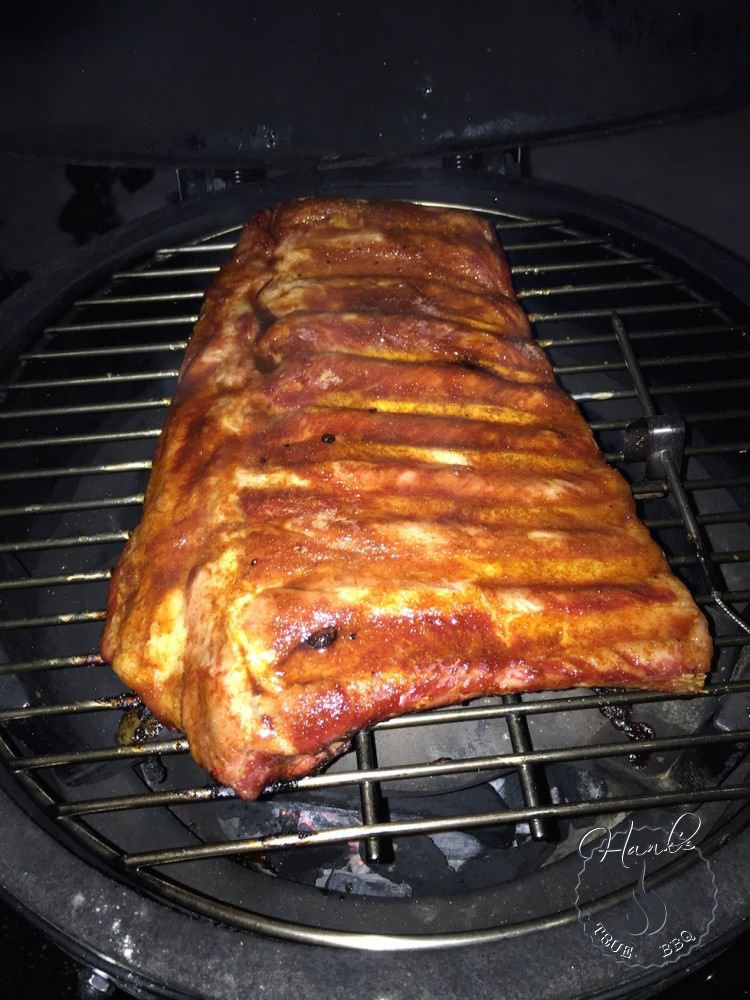
The temperature varies quite a bit inside the dome, and even though the lid thermometer is of good quality most often it is too far away from where the meat is. Therefore: get a good (calibrated) thermometer.
Does the start procedure differ when baking pizza?
Well, not that much. The difference compared to running “low ‘n slow” is that you want it running at a higher temp, typically 300° – 450° F. Once you’ve set fire to the charcoal you let it burn freely for an extra 5 minutes, so the full charcoal load is burning. Then close the lid, and leave the bottom and top vents fully open. When the temperature exceeds 300° F you put the plate setter in place, and leave the grill running another couple of minutes, until the temperature exceeds 400° F. When you’ve gotten this far you have a proper clean burning fire going. Close the top vent so only the small “eyes” are open. This should generate a temperature drop, so you end up running at 300° – 350° F. Start cooking pizzas, the should take approximately 10 minutes each.
How do I smoke in my Big Green Egg?
You don’t have to add other types of wood to get good smoke flavor. The Big Green Egg charcoal is made from oak and hickory, and adds a nice mild smoke flavor in itself. If you want another smoke flavor, or more of it, you add wood chips or chunks. There are many different types of wood, read more on wood and smoking here. Just stay clear of woods with a lot of sap. In other words, skip pine.
Practical pointers and suggestions
- Get a good thermometer. It is an absolute must for getting to know your grill, as well as knowing when the food is cooked to temp. I recommend the Maverick ET-733 or the iGrill 2. They both have a transmitter and a receiver so you can monitor temperatures when leaving the grill. They also have (at least) two probes, so you can monitor both grill temp and meat temp. Again, a thermometer is an absolute must. If you’re looking for a fancier thermometer then check out FireBoard 2. I use it more than anything.
- I often smoke using indirect heat, and I always cover the plate setter with some aluminum foil. This way I don’t have to clean it after each cook.
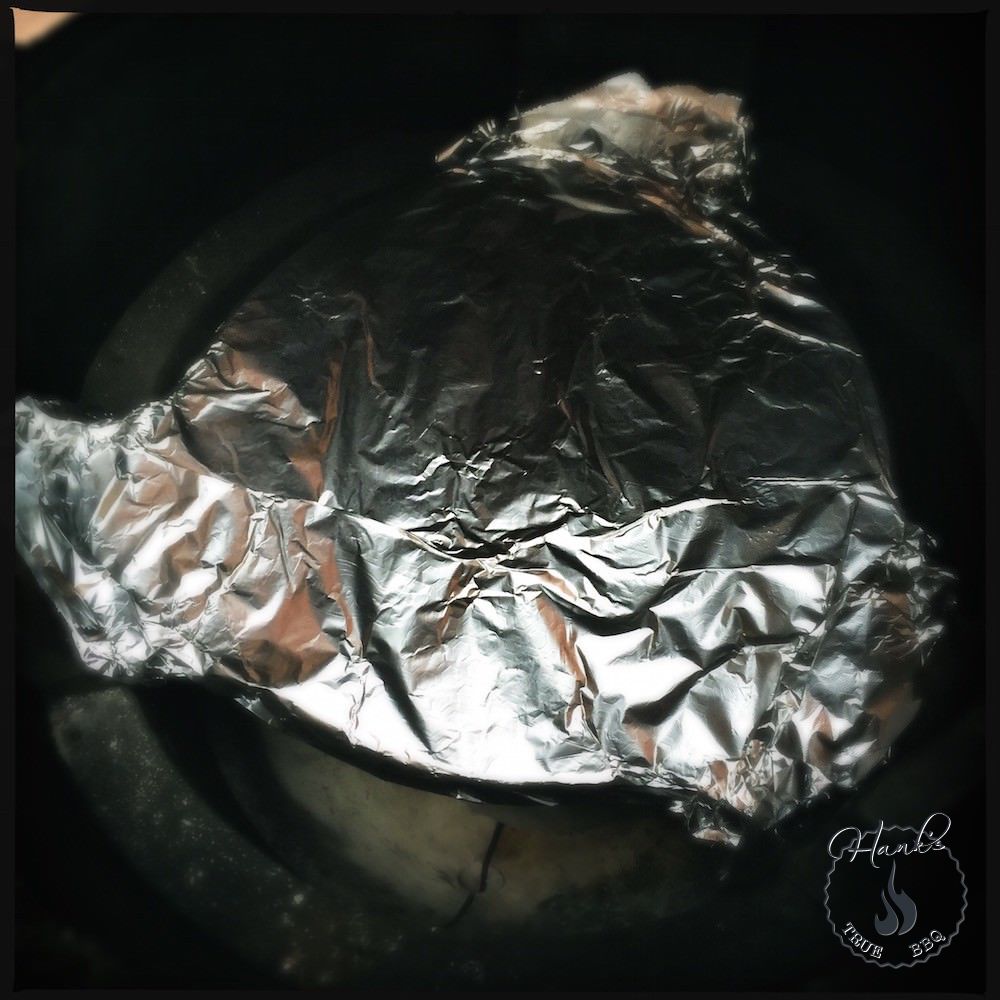
Plate setter with aluminum foil - Use wood chunks instead of wood chips. Chunks burn longer, and it is really tricky to re-fill wood chips mid-cook. You have to refill chips, since they burn up so fast.
- Some people use a water pan to increase humidity in the grill chamber. This is usually not needed in a kamado grill.
- Buy a pair of welding gloves. They are cheap, but worth their weight in gold when you handle hot stuff like a grill.
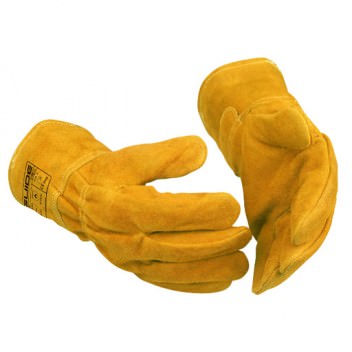
Welding gloves from Bauhaus

